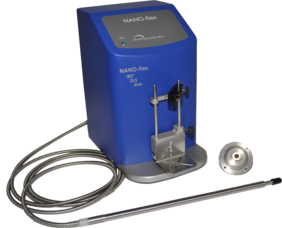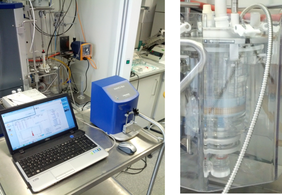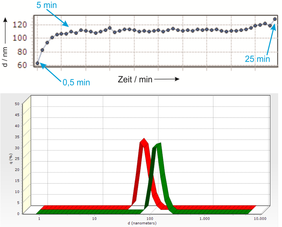In-situ measurement of nano size
When producing polymer nanoparticles it is desirable to monitor the particle size of the developing dispersion in-situ. This can be easily achieved with 180° DLS and the 8 mm Ø measuring probe of the NANO-flex® (Figure 1) within a measuring range from 0.8 nm to 6.5 µm, whereas the concentration can be up to 40 vol% depending on sample and the temperature control reaches up to 90°C. The 180° DLS method is adequately described at www.particle-metrix.de.
Methods and Results
At LLT (Chair for laser technology) in cooperation with Interactive Materials Research DWI (German institute for wool research at RWTH Aachen e.V.) a NANO-flex® size measurement instrument was purchased to track the synthesis of microgels by precipitation polymeri-sation in a reactor (Figure 2) at varying process conditions. In the following example N-Vinylcaprolactam (VCL) with N,N‘-Methylenbisacrylamid (BIS) were radically polymerised at 70°C to obtain a microgel. With high stirring speed the stirrer must be shut off temporarily during measurement. The reaction was tracked at 70°C for 22 minutes. At the beginning the size was 60 nm. Within just 5 minutes the reaction is finished whereas the particle size reached 110 nm as shown in Figure 3.
Figure 3:
left: Trend of the 180° DLS particle size at a reaction temperature of 70°C.
right: Overlay of size measurements after 30 sec (red) and 1500 sec (green).
During the reaction the particle size distribution stays monomodal.
Conclusion
The sensor can be easily integrated to the process; the adjustment of the software to the application is straightforward. Promising results are expected.
Acknowledgement
We would like to thank Interactive Material Research of DWI and the Chair for laser technology at RWTH Aachen for providing the measurement data and the good cooperation.


